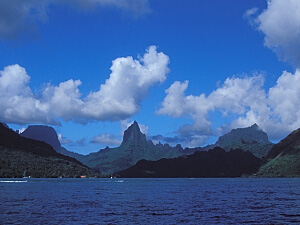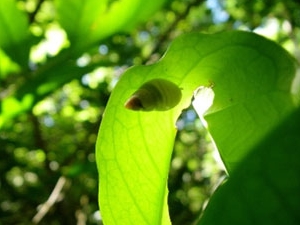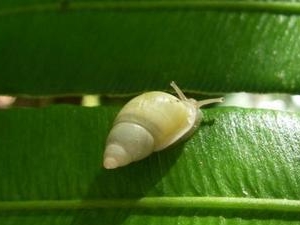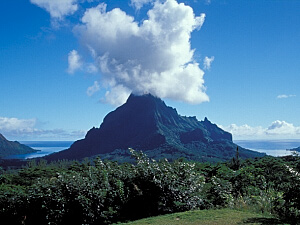
The South Sea island of Moorea, part of the Society Islands.
Picture: Martin Hablützel.
 The South Sea island of Moorea, part of the Society Islands. Picture: Martin Hablützel. |
|
|
For the biologist, isolated ecosystems are of special interest. Isolated ecosystems, among other, can be islands that are not connected to a larger landmass. By this isolation, species evolve here that are found nowhere else in the world. Science refers to those species as endemic. An example for a very large isolated area is Australia. Because of isolation early in earth history, primordial mammals species could evolve to a much larger diversity here than anywhere else in the world. Among those are marsupials and monotremes, which did not go extinct like on most other continents. Another example for isolated ecosystems are islands sufficiently far away from the continents so animals are not able to cross the water. In gastropods, special examples for those endemic species in isolated ecosystems are the tree snails of many island groups, such as the genus Liguus in the Caribbean, the genus Achatinella on the Hawaii islands and the genera Partula and Samoana on the island groups of Polynesia.
The Partula genus of snails home in French Polynesia, the Palau archipelago and the Mariana Islands are mostly small snails with a shell length of few centimetres. Systematically they belong to the terrestrial pulmonate snails (Stylommatophora) and among those to the Sigmurethra, together with the agate snails, similar in appearance, but much larger in size. If a Partula snail is compared to its larger relatives, it is about as large as an agate snail's (e. g. Achatina fulica) egg.
 Partula taeniata. Picture: Trevor Coote, IUCN. |
There are over a hundred of different species of tree snails living on tree trunks in woody habitats, resembling in their shell form. Juvenile specimens usually live in the lower parts of the trees, while the adults climb in higher altitudes. It is estimated, that Partula snails can reach about 5 years of age. Partula snails are viviparous, which is rather uncommon in snails, but found for example as well in European door snails (Clausiliidae).
The story of the Polynesian tree snails is a sad chapter about what happens when man takes influence into an existing ecosystem and how vulnerable the isolated ecosystems if islands can be against influence from outside. Especially this is true for ecosystems in which man has introduced foreign animals, such as domestic animals that inflict damage in nature (pigs, cats and dogs), as well as, if the natural habitats are modified so strongly by agriculture, that the original fauna is rendered incapable to live there.
 Partula taeniata from Haumi valley on Moorea. Picture: Edinburgh Zoo. |
On the Pacific island of Moorea, which belongs to the Society Islands of French Polynesia, the disappearance of Partula snails began with the introduction of giant African land snails.
Those large African land snails mentioned already previously have been spread by man in large parts of the world. Either they were introduced with food transports from their original home countries, or, as was the case in Moorea, were introduced on purpose to be cultivated. The expected economic success of giant African land snail cultivation in French Polynesia in the 1960s did not happen, so the giant snails were just put into nature and left to themselves.
There are no comparable snail species competing on Moorea and the giant land snails also are very adaptive, so their number increased very much, they were even involuntarily distributed by man to other islands. The strong increase of giant land snails, like in other parts of the world, did not go unnoticed. Soon, the giant land snails inflicted such damage to fruit plantations on Moore and other islands, so a solution to the problem had to be found.
 Moorea – an island paradise? Picture: Martin Hablützel. |
Without thinking about the ecological consequences, there was the idea of introducing a predator snail, which was known from America to feed on all kinds of different snails. This snail is the rosy wolf snail (Euglandina rosea). It lives on other terrestrial snails, which it hunts following their slime threads. In doing so, it also climbs trees and crawls short distances under water.
But unexpectedly, the wolf snail did not pursue the large agate snails, but concentrated on the smaller Partula tree snails.
 Rosy wolf snail (Euglandina rosea), adult specimen. Picture by friendly courtesy of Jim Miller, Jacksonville Shell Club. |
Those were completely unable to defend themselves against the introduced predator and so French geneticists had to find to their dismay that Partula species began to disappear one after the other. In 1984, an American study predicted that the Partula species of Moorea would be completely distinct in the time of three years. And indeed in 1987 all free living tree snails on Moorea had disappeared.
In the meantime, international initiatives to save the tree snails had already attempted to collect samples of single Partula species for safekeeping.
Today, colonies of Partula snails are kept in the zoo on the channel island of Jersey (the well known Durrell zoo), in the Shedd aquarium in Chicago, Illinois, in the London zoo and in other zoological gardens. Partula snails are not easily kept, they need an equilibrium of humidity, temperature, light and food, otherwise they will stop reproducing and the colony will die out. At least, some colonies could be maintained. Nowadays there are the first tests to return Partula snails to nature in protected spaces.
Only recently, in April 2010, Bristol Zoo managed to encourage Partula snails of the species Partula faba from the Polynesian island of Raiatea, already extinct in the wild, to reproduce - 15 juveniles with a size of about 2 mm were born alive - Partula faba is an ovoviviparous species.
For some of the Pacific tree snail species all help is too late: They must be assumed extinct and lost forever.
Two other predatory snail species from Africa, Gonaxis quadrilateralis and Gonaxis kibwenziensis have also been introduced to various Pacific islands (for example on Saipan and on Guam) for the same reasons like the rosy wolf snail. They had a similar effect in the endemic terrestrial snail fauna. Tillier and Clarke (1983) assumed that at least a hundred indigenous snail species had already been extinct and that some further hundreds were threatened by extinction. The two African predator snail species also do not hunt the giant African snails, which to control they had originally been introduced, but only their smaller indigenous relatives.